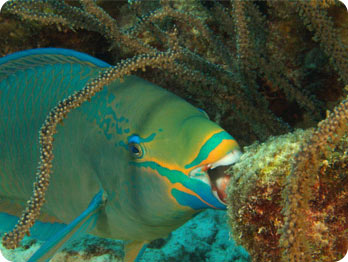Visit most any coral reef in shallow tropical waters and you will likely see colorful parrotfish gliding by, busily grazing on algae. These herbivorous fish are more than just a pretty sight — they are swimming sand factories.
 A parrotfish in the Caribbean Sea uses its beaklike teeth to feed. Credit: Brenda S. Kirkby and R. Duncan Kirkby
A parrotfish in the Caribbean Sea uses its beaklike teeth to feed. Credit: Brenda S. Kirkby and R. Duncan KirkbyThe 80-some species in the parrotfish family get their name from a unique feature: Their front teeth are fused to form plates that resemble a parrot’s beak.
Parrotfish use their beaklike teeth to graze algae that grows on different surfaces in the reef environment. They can scrape and break off pieces of coral, which contain soft coral polyps. Inside the polyps grows a kind of algae called zooxanthellae. To get to the nutritious algae, parrotfish grind up the hard coral skeleton using a second set of specialized teeth located in their throat, known as the “pharyngeal mill.”
After being crushed to fine particles, the bits of coral skeleton travel through the rest of the parrotfish’s digestive tract, and are eventually excreted as white coral sand. Parrotfish “dump” newly digested coral sand into the reef environment every day. With their voracious eating habits, one large individual can produce up to one ton of sand per year.
Because the forces of wind and waves move sand onshore, we can thank parrotfish for helping to create the fine white sand found in reef environments. Also, it’s very likely that the prized beaches near coral reefs where parrotfish roam are made up, in part, by sand that was once a parrotfish snack.


